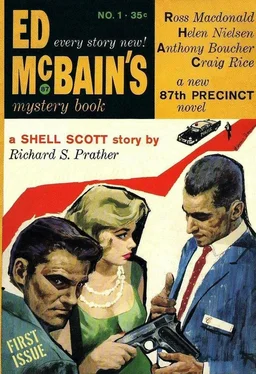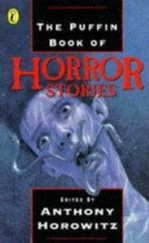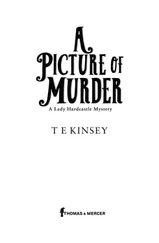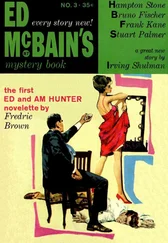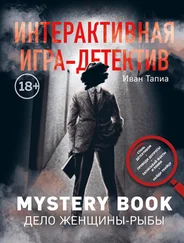Anthony Boucher - Ed McBain’s Mystery Book, No. 1, 1960
Здесь есть возможность читать онлайн «Anthony Boucher - Ed McBain’s Mystery Book, No. 1, 1960» весь текст электронной книги совершенно бесплатно (целиком полную версию без сокращений). В некоторых случаях можно слушать аудио, скачать через торрент в формате fb2 и присутствует краткое содержание. Город: New York, Год выпуска: 1960, Издательство: Pocket Books, Жанр: Детектив, на английском языке. Описание произведения, (предисловие) а так же отзывы посетителей доступны на портале библиотеки ЛибКат.
- Название:Ed McBain’s Mystery Book, No. 1, 1960
- Автор:
- Издательство:Pocket Books
- Жанр:
- Год:1960
- Город:New York
- ISBN:нет данных
- Рейтинг книги:5 / 5. Голосов: 1
-
Избранное:Добавить в избранное
- Отзывы:
-
Ваша оценка:
- 100
- 1
- 2
- 3
- 4
- 5
Ed McBain’s Mystery Book, No. 1, 1960: краткое содержание, описание и аннотация
Предлагаем к чтению аннотацию, описание, краткое содержание или предисловие (зависит от того, что написал сам автор книги «Ed McBain’s Mystery Book, No. 1, 1960»). Если вы не нашли необходимую информацию о книге — напишите в комментариях, мы постараемся отыскать её.
Ed McBain’s Mystery Book, No. 1, 1960 — читать онлайн бесплатно полную книгу (весь текст) целиком
Ниже представлен текст книги, разбитый по страницам. Система сохранения места последней прочитанной страницы, позволяет с удобством читать онлайн бесплатно книгу «Ed McBain’s Mystery Book, No. 1, 1960», без необходимости каждый раз заново искать на чём Вы остановились. Поставьте закладку, и сможете в любой момент перейти на страницу, на которой закончили чтение.
Интервал:
Закладка:
From a moral standpoint, wry appreciation of the talents of a Van Megeeren is understandable. For who is hurt? No damage is done except to the notion of infallibility of the critics and to the silk-lined pocket-book of the purchaser. On the other hand, the damage done by a man who gets his inspiration from the Bureau of Printing and Engraving, or its equivalent, can be monumental. Not only the shopkeeper, inn keeper, and gas-station owner suffer; the economy of an entire nation can be destroyed by the widespread circulation of counterfeit money.
Sturdy Venetian banks were staggered back on their heels in 1470 by the tactics of Duke Gallazeo Sforza of Milan, who made handsome counterfeits of the money of Venice during his war against that city. The idea has been adopted by many warring factions since — by Napoleon against the English, by Pitt against the French. It has been tried in time of peace — the most notable attempt being that of an Austrian prince named Ludwig Windischgraetz. The prince, who had political ambitions in Hungary and a grudge against France, planned in 1923 to print one hundred million dollars’ worth of 1,000-franc notes for a double purpose — to finance a Hungarian putsch and to destroy France’s financial structure. The counterfeits were clumsy, however, the scheme fell through, and the prince, arrested by Hungarian police, was sentenced to four years at hard labor.
Sometimes a quick solution to the budget problem can be more damaging to a country’s economy than a tricky enemy. Nero, Henry VIII, and Frederick the Great ruined the financial structures of their respective countries by issuing debased currency. It was legal and possibly necessary counterfeiting but no less disastrous. Potatoes replaced money.
Since counterfeiting has long been the prerogative of rulers — Polycrates of Samos and Queen Elizabeth also indulged — most of them have taken a dim view of competition by amateurs. The earliest counterfeiters, who clipped coins and made new ones from the shavings, had their ears clipped when caught. King Canute decreed that their hands should be cut off. The Romans deprived counterfeiters of their citizenship and then removed their ears and noses. Later, these steps not considered sufficiently discouraging, their ears, noses, hands, and feet were cut off and what was left was served to hungry lions. One presumes they were hungry. During the Renaissance punishment was equally severe. The counterfeiter’s hands and feet were removed, his eyes were gouged out, and he was drawn, quartered, and put together again so he could be burned at the stake. Counterfeiting remained a flourishing profession, but there were few second-offenders.
In the American colonies in the 1600’s, because cash money was scarce, wampum was used as currency. At first the Indians fooled the settlers with phony wampum, but soon the wily white man turned the tables. Counterfeit wampum made of glass beads was secretly made in England and shipped to America. For a while it fooled the Indians; then wampum currency collapsed.
Counterfeiters of bills of credit — which replaced wampum — were punished, when caught, by being forced to sit in the pillory for an hour, losing an ear, and spending a year in jail. In the pattern of these things, the penalty was not tough enough. So it was jumped to a public whipping, loss of both ears, and being nailed to the pillory. But this did not stop the collapse of currency based on bills of credit.
During the Revolution, in order to create a financial panic among the rebels, the British Government flooded America with fake Continental dollars. In New York Lord Howe advertised sales of counterfeit Continentals for “persons going to the other colonies.” Soon American counterfeiters refused to counterfeit the worthless notes (there is good in everything) and Congress solved the problem by recalling $20,000,000 in Continental currency and destroying it.
Taking a leaf from Howe, Napoleon, and Prince Ludwig, whose operations he studied closely, Adolf Hitler in 1940 launched the biggest and most carefully planned counterfeiting enterprise in history. It was called Operation Bernhard; its original purpose was to destroy the Bank of England.
The immediate supervisor of the project, reporting directly to Heinrich Himmler, was a German Secret Service major, Friedrich Walter Bernhard Kruger, formerly a textile machine engineer. The plan was to print a billion dollars’ worth of British pound notes of various denominations and dump most of them by plane over the British Isles. Most Britishers, it was hoped, would go on a spending orgy, bringing about the collapse of the currency.
The project was carried out with great thoroughness. British banknote paper, made of white linen, could not be obtained in quantity, so linen was imported from Turkey, dirtied by rubbing it on oily machines, and then laundered. An operation was set up in a fenced-off, closely guarded area of the Sachsenhausen concentration camp, near Oranienburg. From concentration camps all over Germany, Czechoslovakia, and Poland specialists were collected, shipped to Sachsenhausen, and pressed into service. Among them were dentists, engineers, engravers, stereotypists, a bank clerk, a printer, and a professional counterfeiter named Solomon Smolianoff, whose value to the enterprise was inestimable.
After a printing shop and photo and engraving sections were set up, the project got rolling in 1943. Watermarks were introduced into the linen, sheets were split in two, then cut in half, the text, denomination, and vignette of Britannia were printed, and finally the serial numbers were added. Forty per cent of the notes were of five-pound denomination; ten-, twenty-, and fifty-pound notes each made up another 20 per cent. On rare occasions 100-, 500-, and 1,000-pound notes were run off.
After meticulous comparison with genuine currency, the notes were divided into four classes: The best were to be used in neutral countries and taken by spies into enemy countries; the next best were to be used for paying off collaborators; the third class was to be dumped over England, and the fourth class, made up of the worst notes, was junked.
Early attempts at distribution met with a snag. Walter Funk, Minister of Economics, forbade the operation in countries occupied by Germany lest it upset currencies he was trying to stabilize. The drop over England was postponed as other uses were found for the money. It was handy for buying up arms parachuted by the Allies to Serb, Croat, and Italian partisans. Information about the whereabouts of Mussolini’s hideout, leading to his abduction from the hands of the Allies by Colonel Skorzeny, was paid for in counterfeit British notes. Phony money was the reward earned by the famous Albanian spy, Eliaza Bazna, valet to the British Ambassador to Turkey. Some of the money, to bolster the Nazi economy, was exchanged for gold in Italy and for francs in Switzerland.
The Bank of England learned of the enterprise in April, 1943, and launched countermeasures. It stopped the issue of notes of ten pounds and higher and began exchanging new ones for those already issued. The new ones had a tricky electrical safeguard — a narrow ribbon of metallic thread in the paper which conducted a particular pattern of electricity under special conditions known only to the Bank of England.
Because of complications arising on the military fronts, Operation Bernhard never reached its ultimate goal, though, thanks to Smolianoff, the counterfeits themselves were close to perfect. A total of $600,000,000 worth of British banknotes were made, $10,000,000 of which got into circulation. The effect on the Bank of England, despite the best of intentions, was troublesome but far from disastrous.
In 1944 Himmler gave Kruger a rush order to counterfeit American paper money. But time ran out before more than twenty $100 bills were finished and okayed by Himmler. The panic occasioned by Allied advances on all fronts drove the Nazis to destroy all plates and wads of spurious British money in outdoor incinerators. More bundles of notes were sunk in lakes and rivers in Austria. Kruger vanished for ten years and turned up as a storekeeper just outside of Hanover.
Читать дальшеИнтервал:
Закладка:
Похожие книги на «Ed McBain’s Mystery Book, No. 1, 1960»
Представляем Вашему вниманию похожие книги на «Ed McBain’s Mystery Book, No. 1, 1960» списком для выбора. Мы отобрали схожую по названию и смыслу литературу в надежде предоставить читателям больше вариантов отыскать новые, интересные, ещё непрочитанные произведения.
Обсуждение, отзывы о книге «Ed McBain’s Mystery Book, No. 1, 1960» и просто собственные мнения читателей. Оставьте ваши комментарии, напишите, что Вы думаете о произведении, его смысле или главных героях. Укажите что конкретно понравилось, а что нет, и почему Вы так считаете.
